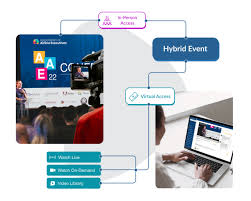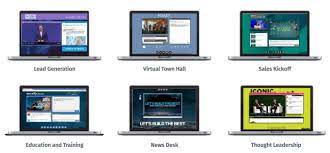The Rise of Hybrid Meeting Platforms
In today’s fast-paced and interconnected world, the way we conduct meetings and events has evolved significantly. With the rise of remote work and the need for flexibility, hybrid meeting platforms have become increasingly popular.
Hybrid meeting platforms combine in-person and virtual elements to create a seamless experience for all participants. This allows individuals to join meetings from anywhere in the world, whether they are in the office, at home, or on the go.
One of the key advantages of hybrid meeting platforms is their ability to increase accessibility and inclusivity. By offering both in-person and virtual options, organizations can accommodate diverse needs and preferences, ensuring that everyone can participate regardless of their location or circumstances.
Furthermore, hybrid meeting platforms promote cost savings and environmental sustainability by reducing the need for extensive travel and physical infrastructure. This not only benefits organizations but also contributes to a more eco-friendly approach to conducting business.
As technology continues to advance, hybrid meeting platforms are expected to become even more sophisticated, offering enhanced features such as interactive tools, real-time collaboration capabilities, and seamless integration with other digital platforms.
In conclusion, hybrid meeting platforms represent the future of modern communication and collaboration. By embracing this innovative approach, organizations can foster greater engagement, productivity, and connectivity among their teams and stakeholders.
9 Advantages of Hybrid Meeting Platforms: Accessibility, Savings, and Beyond
- Increased accessibility for remote participants
- Cost savings on travel and accommodation expenses
- Flexibility to join meetings from anywhere with an internet connection
- Enhanced inclusivity by accommodating diverse needs and preferences
- Reduced environmental impact through less physical infrastructure and travel
- Improved work-life balance for employees with remote work options
- Seamless integration of interactive tools and collaboration features
- Ability to reach a wider audience regardless of geographical location
- Efficient scheduling and coordination of meetings with virtual options
Four Key Challenges of Hybrid Meeting Platforms: Technical Disruptions, Engagement Disparities, Networking Hurdles, and Security Risks
- Technical issues and connectivity problems can disrupt the meeting experience.
- Difficulty in maintaining equal engagement levels between in-person and virtual participants.
- Potential challenges in facilitating networking and informal interactions in a hybrid setting.
- Security concerns related to data privacy and confidentiality during virtual meetings.
Increased accessibility for remote participants
Hybrid meeting platforms offer a significant advantage by increasing accessibility for remote participants. By providing the option to join meetings virtually from anywhere in the world, individuals who are not able to attend in person due to geographical constraints, scheduling conflicts, or other reasons can still actively participate. This inclusivity ensures that all team members, clients, or stakeholders have the opportunity to contribute and engage in discussions, fostering collaboration and communication across diverse locations and time zones.
Cost savings on travel and accommodation expenses
One significant advantage of hybrid meeting platforms is the cost savings they offer on travel and accommodation expenses. By enabling participants to join meetings remotely from their own locations, organizations can significantly reduce the need for expensive travel arrangements and accommodation costs. This not only helps businesses save money but also promotes a more efficient and sustainable approach to conducting meetings and events.
Flexibility to join meetings from anywhere with an internet connection
One of the key advantages of hybrid meeting platforms is the flexibility they offer in allowing participants to join meetings from anywhere with an internet connection. This feature enables individuals to engage in meetings remotely, whether they are working from home, traveling, or simply unable to attend in person. By providing this level of accessibility, hybrid meeting platforms empower teams to collaborate effectively and stay connected regardless of their physical location, ultimately enhancing productivity and fostering a more inclusive work environment.
Enhanced inclusivity by accommodating diverse needs and preferences
Hybrid meeting platforms offer a significant advantage by enhancing inclusivity through accommodating diverse needs and preferences. By providing both in-person and virtual options, these platforms ensure that individuals from various locations and circumstances can participate in meetings and events. This flexibility promotes equal access to information and opportunities, fostering a more inclusive environment where everyone’s voice can be heard and valued.
Reduced environmental impact through less physical infrastructure and travel
One significant advantage of hybrid meeting platforms is the reduced environmental impact they offer through the decrease in physical infrastructure and travel requirements. By enabling participants to join meetings remotely, organizations can significantly cut down on the need for extensive travel, thereby reducing carbon emissions and promoting a more sustainable approach to conducting business. Additionally, the decreased reliance on physical infrastructure not only minimizes resource consumption but also contributes to a more eco-friendly operational model. Overall, embracing hybrid meeting platforms can play a crucial role in helping organizations reduce their environmental footprint and support global sustainability efforts.
Improved work-life balance for employees with remote work options
Hybrid meeting platforms offer a significant benefit by improving work-life balance for employees through remote work options. By providing the flexibility to participate in meetings virtually, employees can better manage their personal and professional responsibilities, leading to reduced stress and increased job satisfaction. This flexibility allows employees to avoid long commutes, spend more time with their families, and create a more customized work environment that suits their individual needs and preferences. Ultimately, the ability to work remotely via hybrid meeting platforms contributes to a healthier work-life balance, resulting in happier and more productive employees.
Seamless integration of interactive tools and collaboration features
One significant advantage of hybrid meeting platforms is their seamless integration of interactive tools and collaboration features. By incorporating these capabilities, participants can engage in real-time discussions, share documents, and collaborate on projects effortlessly. This not only enhances the overall meeting experience but also fosters greater teamwork and productivity among remote and in-person attendees. The ability to leverage interactive tools and collaboration features in a unified platform streamlines communication and decision-making processes, ultimately leading to more efficient and effective meetings.
Ability to reach a wider audience regardless of geographical location
One significant advantage of hybrid meeting platforms is their ability to reach a wider audience regardless of geographical location. By offering virtual participation options, organizations can connect with individuals from around the world, breaking down barriers imposed by distance and time zones. This increased accessibility allows for greater inclusivity and diversity in meetings and events, fostering collaboration and engagement among a broader range of participants.
Efficient scheduling and coordination of meetings with virtual options
Efficient scheduling and coordination of meetings with virtual options is a significant advantage of hybrid meeting platforms. By offering the flexibility for participants to join remotely, organizations can overcome scheduling conflicts and logistical challenges that often arise with in-person meetings. This feature allows for greater accessibility and participation from individuals located in different time zones or unable to attend in person, resulting in improved efficiency and productivity in meeting coordination. Additionally, the virtual options enable seamless integration of remote attendees, fostering collaboration and communication among team members regardless of their physical location.
Technical issues and connectivity problems can disrupt the meeting experience.
One significant drawback of hybrid meeting platforms is the potential for technical issues and connectivity problems to disrupt the meeting experience. These issues can range from audio and video glitches to network instability, causing delays, interruptions, and frustration among participants. Such disruptions not only impact the flow and effectiveness of the meeting but also hinder communication and collaboration, leading to decreased productivity and engagement. Organizations utilizing hybrid meeting platforms must proactively address these challenges through robust technical support, contingency plans, and regular system maintenance to minimize disruptions and ensure a smoother meeting experience for all involved.
Difficulty in maintaining equal engagement levels between in-person and virtual participants.
One significant challenge of hybrid meeting platforms is the difficulty in maintaining equal engagement levels between in-person and virtual participants. In a hybrid setting, there is a risk that virtual attendees may feel disconnected or overlooked compared to those physically present in the meeting room. This disparity in engagement levels can hinder effective communication, collaboration, and decision-making, potentially leading to feelings of exclusion and disengagement among remote participants. Organizations must proactively address this con by implementing strategies to ensure that all attendees, regardless of their location, have equal opportunities to participate, contribute, and feel valued during hybrid meetings.
Potential challenges in facilitating networking and informal interactions in a hybrid setting.
One of the potential challenges of hybrid meeting platforms is the difficulty in facilitating networking and informal interactions in a hybrid setting. In traditional in-person meetings, participants have natural opportunities to engage in casual conversations, exchange ideas, and build relationships outside of the formal agenda. In a hybrid environment, remote attendees may feel isolated or excluded from these spontaneous interactions, leading to a lack of connection and camaraderie among all participants. Finding effective ways to replicate the organic networking experience virtually poses a significant challenge for organizers and may require intentional planning and innovative solutions to bridge this gap in communication and engagement.
Security concerns related to data privacy and confidentiality during virtual meetings.
One significant con of hybrid meeting platforms is the heightened security concerns related to data privacy and confidentiality during virtual meetings. With sensitive information being shared and discussed online, there is a risk of unauthorized access, data breaches, and potential leaks of confidential information. Ensuring robust security measures, such as encryption protocols, secure login procedures, and restricted access controls, is crucial to mitigate these risks and safeguard the integrity of virtual meetings. Organizations must prioritize data protection and privacy to maintain trust and credibility in their virtual communication practices.


